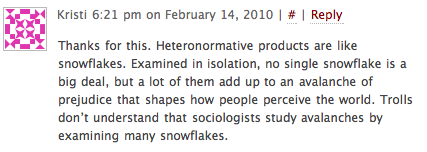In honor of Valentine’s Day, I thought I’d repost part of a entry that I did about Valentine’s Day for my politics of sex class last spring.
What does some queer/feminist thinking about this holiday look like? In my version, it requires paying serious attention to the holiday and exposing and critically engaging with the variety of levels and locations of power and privilege that are involved in our practices and understandings of it. This close attention doesn’t mean that we must reject Valentine’s Day. In fact, I’m not interested in being for or against the holiday. Instead, I am interested in tracing its effects and how that tracing might make visible some processes and practices of heterosexualization. So, here are some questions that V Day raises for me:
Marketing
How is Valentine’s Day marketed to/for women? To/for men? Do the advertisements help reinforce strict divisions (straight thinking) between the “sexes”? How do advertisers encourage us to buy their V-Day products? Do their methods work to reinforce harmful stereotypes about femininity? About masculinity? Do they draw upon other stereotypes (racial, ethnic, class) in their attempts to make their product desirable to us?
Check out the following commercials. Do you see evidence of “straight” thinking here? What are the potentially harmful consequences of these ads? (How) do they encourage us to privilege certain behaviors/identities/bodies over others?
(the first one comes from a student in my politics of sex class):
Description: The guy is struggling to figure out what message to write on a card for his girlfriend. Faith Hill tells him to “speak from his heart.” He writes: “Your rack is unreal.” Text at the end: Telefora says it beautifully. Because, frankly you can’t.
Consider what Ingraham states in “Introduction: Thinking Straight” about “the ways in which ascribed behaviors for women and men–gender–actually organize the institution of heterosexuality” (4). How are masculinity and femininity shaped/reinforced through these advertisements? How do these ads speak to/reinforce larger stereotypes and expectations of what “real” men and women look like? And how they are expected/assumed to act? What do we “learn” about sexuality and straight thinking in these ads?
What about the couples? Which couples are represented in the second ad? Which types of couples are excluded? If, as the New York Times suggests here, that interracial marriages are on the rise, why aren’t any interracial couples represented here? What about same sex couples?
Regardless of whether or not you find these funny, how do labeling them “just a joke” or a funny (and therefore meaningless) commercials prevent us from interrogating their underlying ideologies/structures/patterns? Check out this comment by Kristi on Valentine’s Day and Heteronormativity (note: troll refers to someone who uses their comments to side-track discussions and provoke others who are seriously engaging with the issues in the blog post.)
How do we place the “jokes” from these two commercials into the larger context of how women are objectified (reduced to their “rack”) or who can marry and/or should partner (opposite sex, same race)?
Labor, production and consumption
In “Heterosexuality: I’s Just Not Natural!,”Ingraham argues that events, like weddings or Valentine’s Day, provide us with the opportunity for investigating “the ways various practices, arrangements, relations, and rituals work to standardize and conceal the operation ” (77) of heteronormativity. She also encourages us to ask after whose interests are being served with these practices and at whose expense these practices are encouraged and perpetuated. While there are many different ways to pose these questions, how can we ask them in relation to labor, production and consumption? At whose expense are we able to acquire the products that we use to “express” our love?
Who makes the products that we buy for Valentine’s Day? Who cuts the flowers? Where does the chocolate come from? Are Valentine’s products gendered? How are our expressions of love linked to consumption in Valentine’s Day, where love = the amount of money you spend?
Relationships
When do we start learning appropriate sexual/gender behavior? What is the link between Valentine’s Day and romance/romantic love? How have feminists critically analyzed romantic love? Can anyone be against love? What would it mean to be against love? How does being single get read as failure before/during/after Valentine’s Day? What other ways can we imagine love, intimacy, connection with others outside of heterosexual monogamy via marriage? Check out what the Zachari C has to write about it over at the Crunk Feminist Collective:
I want to live in a world where there isn’t a hierarchy of relationships, where romantic love isn’t assumed to be more important than other kinds, where folks can center any relationships they want whether it be their relationship to their spiritual practice, kids, lovers, friends, etc. and not have some notion that it’s more or less important because of who or what’s in focus. I want to feel like I can develop intimacy with people whether we are sleeping together or not that I will be cared for whether I am romantically involved with someone or not. I want a community that takes interdependency seriously that doesn’t assume that it’s only a familial or romantic relationship responsibility to be there for each other.
What configurations of loving community and kinship does Valentine’s Day foreclose with its almost singular focus on romantic love as man + woman = marriage? Are there ways to rethink love and sexuality that make room for envisioning (heterosexual/monogamous) marriage as one option among many instead of as the only (natural/normal) option?
Public/Private
How do we negotiate our private lives (our relationships, our expressions of intimacy) in public spheres via holidays like Valentine’s Day? How does our participation in V Day (or other heteronormative rituals like weddings) “signify belonging to society in a deep and normal way” (Warner/Berlant, “Sex in Public” 554)? What are the consequences for not participating in these rituals and not reinforcing dominant norms? Who all is excluded from participating in these public rituals and how are they excluded?

